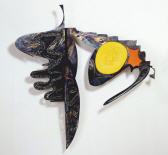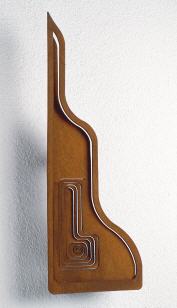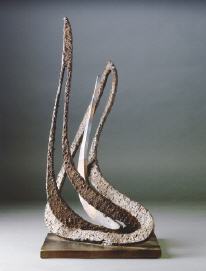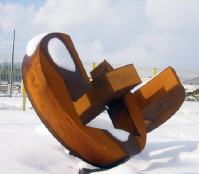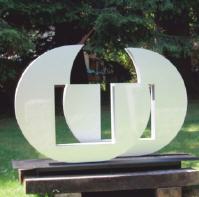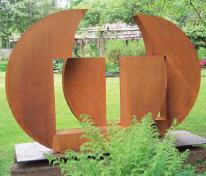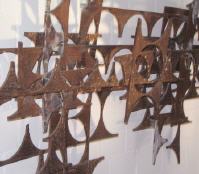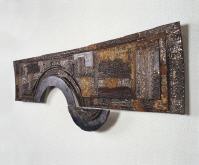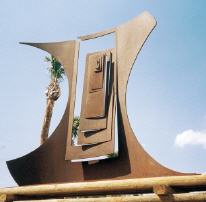artist
1947, Iron Sculptor, Swiss
lives and works in Zofingen, Stansstad, Ticino
A multi-faceted man who fits perfectly the "Continental Gentleman" title, M. Aeschlimann heads a highly successful manufacturing business in Europe, maintains his Swiss citizenship and still finds time in his demanding world to devote to his passion: SCULPTURE. As an entrepreneur and engineer, Heinz Aeschlimann closely communes with his environment, observing the perpetual confrontation and tension between resistance and harmony, nature, technology and humanity. The artistic expression of these constant influences and emotions and their conversion into creative energy allows him to escape the pressures of day to day life. The shapes of his creations, always unique but always created with a deep respect for harmony, often reflect his executive and dynamic personality. The surface treatment of many of his artworks paint a completely different icture of the artist. Sensitively executed highly individualized techniques enable his sculptures to make special statements all of their own. In the tradition of Swiss precision, iron is treated and welded with greatest of care.In his 35 years of creative work, the artist has evolved considerably. The early years show an intensive preoccupation with opposites – good and evil – positive and negative. Entangled with one another or paired next to each other, these opposites are expressed, always accented by different surface treatments. For some time now, Heinz Aeschlimann forms his sculptures into even more complex shapes, connects the different elements of his works into a network of carefully designed and crafted relationships. These partially overlapping surfaces, constructed in various layers, appear to be living organisms in various states of growth or decay. Together with their unique surface textures, these designs result in an intricate interplay of light, colour and shadow. Since 1970 Heinz Aeschlimann created a number of iron sculptures; Small table sculptures, free standing ones or reliefs, to monumental pieces with weight of several tonnes, intended for display in gardens and parks. Even the largest pieces, however, never feel heavy but light and airy, elegant and sophisticated, an impression which is enhanced by excellent technical execution.
In 2002 Heinz Aeschlimann created his Monte Ceneri Sculpture Park, selected iron sculptures are placed under century-old trees , permanently enlarged with new works. An installation of 200 tonnes granite shows his lifecycle, the ups and downs of life, impressively and poetically expressed. During his decades of creativity, Heinz Aeschlimann has exhibited in Switzerland and abroad. His pieces have made their way to art lovers in Europe, the USA, Canada and Asia. The invitation by world renowned curators to participate at important exhibitions in the USA like Navy Pier Walk in Chicago and Orlando Downtown, is in time a highlight in Heinz Aeschlimanns artistic life.
Heinz Aeschlimann is an international succesful swiss artist. The 22nd October 2011, at the occasion of the 200th anniversary of Franz Liszt, Heinz Aeschlimann ist going to donate the steel-made-sculpture "Composer 2011 - the dominating composer" to the Franz-Liszt-Society Burgenland (Austria).The sculpture ‘Composer’ was specially created for Raiding, Franz Liszt’s birthplace. Since his youth, the artist Heinz Aeschlimann has been a great admirer of Franz Liszt and his music since 40 years. Some of the Composer statues lead an itinerant life. Besides the one in Raiding, there are currently ‘Composers’ in several different places around the globe.
Working methodically, perhaps the concomitant of his engineering genius, he creates in what he describes as "phases."
In phase one, he visualizes, internally, the forms and the elements emerging, and then transfers these ideas to paper on his drawing board. These patterns are used to cut iron to form in thickness of 6 - 150 mm.
The second phase is when he forms and processes the delivered steel parts in his atelier in Zofingen by the use of great presses and steel rollers as well as by welding and the application of heat. He forms the elements to a composition, melts them with welding electrodes or by use of a welding torch and gives the sculpture final form.
Phase three, as he describes it, is when he carries out the ensuing surface treatment with various welding techniques and mechanical methods. A distinguishing characteristic of the artist's work is the special welded structure with which he coats the surfaces of his sculpture. With the carefully directed application of heat, he elicits the hidden beauty of the iron, a shimmering play of colors. This gives the sculpture an especially intensive expressive power.
Textured surfaces and interrelated moving forms are a constant challenge to M. Aeschlimann who continues, as a civil engineer, to stay in close touch with his environment and remains intensely aware of the hindrances and harmonies within nature. He strives to transform everyday excitements and impressions into creative energy as a means of relaxation and freedom from worldly cares.
Sometimes large, sometimes bordering on the monumental, Aeschlimann works have stature and perspective which reflect the somewhat serene and cosmopolitan nature of their creator.
THE COMPOSER
by Heinz Aeschlimann, St. Urban, Switzerland. Dedicated to Franz Liszt (1811 – 1886)
Inspired by Liszt’s personality and work, Aeschlimann has been working on the theme of 'composer' for more than forty years. This has given rise to a cycle of unique spatial sculptures on the topic. The various sculptures on the ‘composer’ theme can be found today in internationally renowned collections and exhibitions. They are buoyant yet solemn, of a lofty elegance and delicate grace, imbued with both lightness and gravity - an expression of the inconstancy and fluctuations of our emotions. The unexpected dynamic variations, the balance between elastic vitality and soothing rhythms, and the ability to transcend and overcome Earth's gravity are musical and sculptural mechanisms which characterise both Liszt’s music and Aeschlimann’s sculptures.
The sculpture ‘Composer’ was specially created for Raiding, Franz Liszt’s birthplace. The work with its three symbolising elements stands facing the house in which Liszt was born. The construction is composed of three sub-elements connected through the interplay of concave and convex forms, whose effect is intensified or diminished depending on the position of the observer. Despite the resistance of the weighty metal, Aeschlimann is able to lend a dynamism and particular lightness to the three main elements by creating a number of openings in the sculpture. Like Liszt in his musical compositions, Aeschlimann also seeks to overcome the ‘inertia of mass’ and give his work grace and timeless elegance by creating ingenious yet simple forms.
Of particular interest is the way in which our eyes are directed through the sculpture up towards the sky or to the landscape beyond, as if the artist were trying to expand the dimensions of space to infinity. Through the interplay of the three main elements, Aeschlimann creates a spacious system without beginning or end, which moves back into itself or out into the open. Daylight models the sculpture in different ways depending on the time of day and year and the varying weather conditions. This results in a myriad of patterns of light and shade, reflections and perspectives, transforming the heavy steel construction in a curious manner. The longer we abandon ourselves to this interplay of forms and movement, the lighter and more buoyant the sculpture becomes; the matter adopts a transparent and weightless quality, as if borne along by inner forces to the point of dematerialisation.
‘Composer’ can therefore also be viewed as homage to the great Franz Liszt. The elevated central section clearly symbolises Liszt the maestro as a masterful, dominant personality. The element to the left represents the grandiose musical work. The third, right-hand section of the sculpture stands for the human social context, the great master's close contemporaries, in particular the circle of inspiring and seductive ladies whose presence is expressed in subtly erotic form in the musical oeuvre. These works of art, both Franz Liszt’s creations and Heinz Aeschlimann’s ‘Composer’ sculptures, are pervaded by a sense of humanity which does not fail to grasp our attention and move us in different ways.
Roy Oppenheim, art historian

